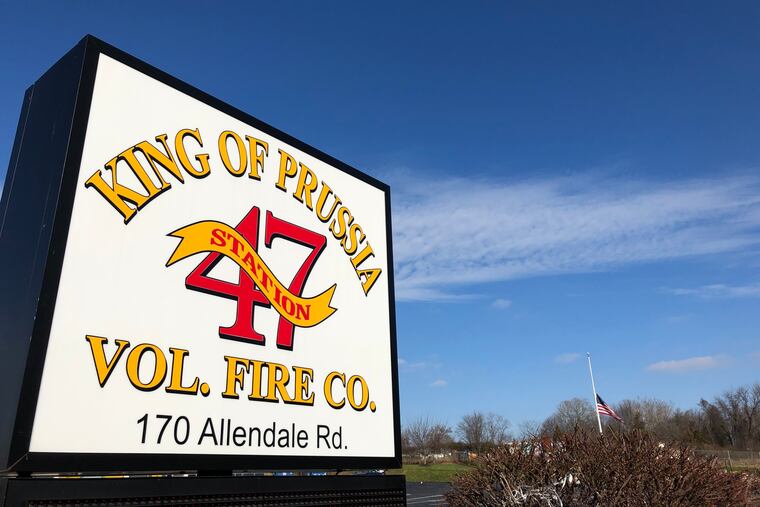Upper Merion hired career firefighters to help its dwindling all-volunteer forces. Others think it could be a model.
Upper Merion's population continues to grow and, with it, the number of calls to its all-volunteer fire companies. Meanwhile, in line with national trends, the number of volunteers has been dwindling for decades.

When the chiefs of the three volunteer fire squads serving Upper Merion came to the township’s board of supervisors, they were desperate.
We need some help, they said. Scraping together enough members to respond to emergencies was becoming difficult, especially during the day.
The Montgomery County township’s population continues to grow and, with it, the number of calls to the all-volunteer companies based in Swedeland, King of Prussia, and Swedesburg. The volunteers respond to 1,200 to 1,500 fire calls each year. Meanwhile, in line with national trends, their numbers have been dwindling for decades.
So Upper Merion hired six full-time career firefighters who also are trained emergency medical technicians to reinforce the volunteer fire companies and the combination volunteer and career ambulance company that serve the township. They started work last week.
“Recognizing that volunteers are less available during traditional business hours, we needed to make sure we could have an adequate staffing model to meet the demands," said Bill Jenaway, a township supervisor and president of the King of Prussia Volunteer Fire Company. "This gives us a little extra guarantee.”
Fire departments across and beyond the region are taking notice. Officials are asking Upper Merion to let them know in six to nine months how the system is working and any challenges they encounter. At a meeting of the Congressional Fire Services Institute in Washington this month, others pressed Jenaway, president of the board of directors, for details on his township’s setup.
>>READ MORE: Alarming situation: Volunteer fire companies fight shortage ‘crisis’
The majority of the nation’s fire departments are entirely volunteer, and communities save a total of nearly $47 billion a year by relying on volunteers, according to the National Volunteer Fire Council. Upper Merion alone saves more than $12 million a year by using volunteer rescue personnel, according to the township.
So departments and their communities are trying whatever they can to keep the volunteer model. That includes offering tax credits, education reimbursement, and housing; collaborating more often with other fire companies; and — if possible — paying stipends to volunteers or salaries to career staff.
>>READ MORE: Fire departments, desperate for volunteers, get creative
The percentage of departments that combine both volunteer and career firefighters has inched up nationwide, from about 20 percent in 2000 to nearly 25 percent in 2015, according to the National Fire Protection Association.
The growth of suburban communities is part of the reason, said Kimberly Quiros, chief of communications for the National Volunteer Fire Council. The bigger the community, the larger its tax base, and the more it is likely to be able to afford career staff.
Most volunteer fire companies cover rural areas.
“A lot of volunteer departments are running on a shoestring budget and are barely able to get the equipment their staff needs, let alone hiring career staff,” Quiros said. "A lot of communities just can’t support that system, because they’ve always had volunteers.”
Upper Merion’s fire companies approached the board of supervisors two years ago, asking for career staff. But the worry started well before then.
"About six years ago, we got to where we thought it was a critical stage,” said Jim Gallagher, chief of the King of Prussia Volunteer Fire Company.
His company had 62 members in 2000. Now, it has 26.
The departments tried to solve their problem other ways, including applying for volunteer staffing grants from the Federal Emergency Management Agency. But coverage during the day was a stubborn problem.
The King of Prussia station is often unstaffed when a call comes in during a weekday, and volunteers travel from work or home. If the company doesn’t respond to a fire within five minutes, Chester County’s emergency dispatch system sends other companies. That happened roughly 10 times in the first half of the year.
Upper Merion approved the career firefighter positions as part of the budget it passed a year ago. The township hired its first chief of fire and emergency medical services in September. The career firefighters will operate mainly out of one station and work as a team, responding to fire calls, inspecting buildings, and teaching fire safety throughout the township.
Fire chiefs everywhere are watching, said Neil Vaughn, president of the Chester County Fire Chiefs Association.
“I certainly think that people will keep an eye on this to see how it works and see what the feasibility is for their municipality and/or fire company," he said.